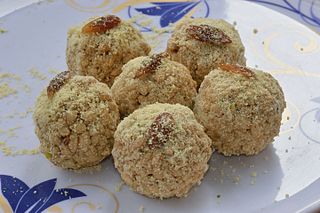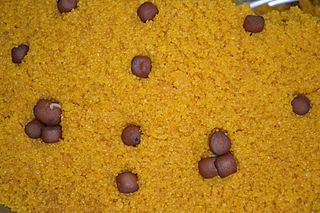Related Research Articles

Basmati is a variety of long, slender-grained aromatic rice which is traditionally grown in the Indian subcontinent, mainly India, and Pakistan, as well as some regions of Sri Lanka and Nepal. As of 2019, India accounted for 65% of the international trade in basmati rice, while Pakistan accounted for the remaining 35%. Many countries use domestically grown basmati rice crops; however, basmati is geographically exclusive to certain districts of India and Pakistan.

Darjeeling District is the northernmost district of the state of West Bengal in eastern India in the foothills of the Himalayas. The district is famous for its hill station and Darjeeling tea. Darjeeling is the district headquarters. Kurseong, Siliguri and Mirik, three major towns in the district, are the subdivisional headquarters of the district. Kalimpong was one of the subdivisions but on 14 February 2017, it officially became a separate Kalimpong district.

Cooch Behar district is a district of the Indian state of West Bengal. Formerly part of the Kamarupa kingdom, the area became the heart of the Kamata Kingdom in the 12th century. During the British Raj, the district was known as Cooch Behar state ruled by the Koch dynasty until 1949, when it became part of India. The district consists of the flat plains of North Bengal and has several rivers: the most notable being the Teesta, Jaldhaka and Torsa. The district has the highest proportion of Scheduled Castes in the country, where they form a majority.

Jalpaiguri district is a district of the Indian state of West Bengal. The district was established in 1869 during British Raj. The headquarters of the district are in the city of Jalpaiguri, which is also the divisional headquarters of Jalpaiguri division.
Ambemohar is a fragrant rice variant grown in the foothills of the Western ghats region of the state of Maharashtra in India.

Alipurduar district is the 20th district in the state of West Bengal, India. The district has its headquarters at Alipurduar. It was made a district by bifurcating Jalpaiguri district in 2014. The district consists of Alipurduar municipality, Falakata municipality and six community development blocks: Madarihat–Birpara, Alipurduar–I, Alipurduar–II, Falakata, Kalchini and Kumargram. The six blocks contain 66 gram panchayats and nine census towns.

Jaynagarer Moa is a seasonal Bengali sweetmeat delicacy prepared from date palm jaggery and Kanakchur khoi. This variety of Moa originated in Jaynagar Majilpur of the South 24 Parganas district in the Indian state of West Bengal. It is now a popular sweet, being produced in Kolkata and elsewhere, sometimes with cheaper ingredients and chemical flavours. Jaynagarer Moa was given a Geographical Indication tag in 2015 which will enable the product to be protected from unauthorized uses and piracy.

Kalanamak is a scented rice of Nepal and India. Its name means black husk. This variety has been in cultivation since the original Buddhist period. It is popular in Himalayan Tarai of Nepal i.e., Kapilvastu, and eastern Uttar Pradesh, where it is known as the scented black pearl. It was featured in the book Speciality rices of the world by Food and Agriculture Organization of the United Nations.

Gandhakasala rice is a variety of rice cultivated by the farmers in Wayanad District in Kerala. This is a scented variety of rice grown mostly by the members of the tribal communities of in Panamaram, Sultan Bathery, and Mananthavady areas in Wayanad. As of 2010, gandhkasala is cultivated in an area of 327 hectares and jeerakasala in 22 hectares. Wayanad Gandhakasala rice]] is known for its sandalwood-like flavor, while Wayanad Jeerakasala rice resembles cumin seeds in both appearance and taste and are so unique from one another.
Wayanad Jeerakasala rice is a variety of traditional, non-Basmati, medium-grained aromatic rice with golden yellow colour mainly grown in the Indian state of Kerala. It is a common and widely cultivated crop in Wayanad district. The other variety from the same region, Wayanad Gandhakasala rice is known for its sandalwood-like flavor, while Wayanad Jeerakasala rice resembles cumin seeds in both appearance and taste and are so unique from one another.

Kalimpong district is a district in the state of West Bengal, India. In 2017, it was carved out as a separate district to become the 21st district of West Bengal. The district is headquartered at Kalimpong, which grew to prominence as a market town for Indo-Tibetan trade during the British period. It is bounded by Pakyong district of Sikkim in the north, Bhutan in the east, Darjeeling district in the west, and Jalpaiguri district in the south.

Mihidana is an Indian sweet from Burdwan, West Bengal, India. Mihidana, described as the micro cousin of the traditional Boondi, is derived from two words, Mihi meaning fine, and Dana, meaning grain.
Ajara Ghansal is a variety of non-Basmati aromatic rice mainly grown in the Indian state of Maharashtra. It is a common and widely cultivated crop in Ajara taluka of Kolhapur district.
Balaghat Chinnor is a variety of non-Basmati aromatic rice mainly grown in the Indian state of Madhya Pradesh. It is a common and widely cultivated crop in tehsils of Balaghat, Baihar, Birsa, Paraswada, Katangi, Waraseoni, Lalbarra, Khairlanji, Lanji and Kirnapur of Balaghat district
Marcha rice is a variety of non-Basmati, short-grained aromatic rice mainly grown in the Indian state of Bihar. It is a common and widely cultivated crop in Ramnagar, Gaunaha, Mainatand, Chanpatiya, Narkatiyaganj and Lauriya blocks of West Champaran district.
Koraput Kalajeera rice is a variety of non-Basmati, aromatic, black paddy coloured, small rice mainly grown in the Indian state of Odisha. It is a common and widely cultivated crop in the Koraput district of Odisha as well as Nabarangapur district which was earlier a part of Koraput. For thousands of years, the ancestors of Koraput's present tribal communities have cultivated and domesticated Kalajeera rice, playing a crucial role in its conservation.
Uttarakhand lal chawal is a variety of non-Basmati, aromatic, red colored rice mainly grown in the Indian state of Uttarakhand. This rice variety is grown in the high-altitude regions of Uttarakhand. It is a common and widely cultivated crop in Purola, Mori, and surrounding areas in Uttarkashi district.
Adamchini Chawal is a variety of non-Basmati, traditional, short-grained aromatic rice mainly grown in the Indian state of Uttar Pradesh. It is a common and widely cultivated crop in Chandauli, Mirzapur, Varanasi and Sonebhadra, and Vindhya region of Eastern Uttar Pradesh.
Arunachal Pradesh Khaw Tai (Khamti Rice) is an indigenous variety of non-Basmati, short-grained bold aromatic rice mainly grown in the Indian state of Arunachal Pradesh. It is a common and traditionally widely cultivated crop by Khampti tribe farmers in Namsai, Changlang, and Lohit districts. Under its Geographical Indication tag, it is referred to as "Arunachal Pradesh Khaw Tai (Khamti Rice)".
References
- ↑ "Kalo Nunia: The Indigenous Scented Rice Cultivar from the Northern Parts of Bengal". Vigyan Varta. 5 (2): 152–157.
- ↑ Mondal, D.; Kantamraju, P.; Jha, S.; Sundarrao, G. S.; Bhowmik, A.; Chakdar, H.; Mandal, S.; Sahana, N.; Roy, B.; Bhattacharya, P. M.; Chowdhury, A. K.; Choudhury, A. (2021). "Evaluation of indigenous aromatic rice cultivars from sub-Himalayan Terai region of India for nutritional attributes and blast resistance". Scientific Reports. 11 (1): 4786. Bibcode:2021NatSR..11.4786M. doi:10.1038/s41598-021-83921-7. PMC 7910543 . PMID 33637778.
- ↑ "Honey, Tangail, Garad among 5 more West Bengal products to get GI tag". The Times of India. 5 January 2024. Retrieved 23 November 2024.
- ↑ Bharat, E. T. V. (4 January 2024). "Five Bengal products including Sundarbans honey get GI tag". ETV Bharat News. Retrieved 23 November 2024.
- ↑ "Bengal's own Gobindabhog and Tulaipanji soon to get a distinct stand on world map". The Indian Express. 2 January 2024. Retrieved 23 November 2024.
- ↑ Khush, Gurdev S.; Hettel, Gene; Rola, Tess (1996). Rice Genetics III: Proceedings of the Third International Rice Genetics Symposium, Manila, Philippines, 16-20 October 1995. Int. Rice Res. Inst. ISBN 978-971-22-0087-8 . Retrieved 23 November 2024.
- ↑ Roychoudhury, Aryadeep (29 July 2020). Rice Research for Quality Improvement: Genomics and Genetic Engineering: Volume 2: Nutrient Biofortification and Herbicide and Biotic Stress Resistance in Rice. Springer Nature. ISBN 978-981-15-5337-0 . Retrieved 23 November 2024.
- ↑ Sarker, Dilip De; Saha, Manas Ranjan; Saha, Subrata (1 January 2015). Perspective of dietetic and antioxidant medicinal plants. Notion Press. ISBN 978-93-84878-95-5.
- 1 2 "Kalonunia Rice". Intellectual Property India. Retrieved 23 November 2024.
- ↑ Sanjivani Karki; Mrityunjay Ghosh; Binoy Chettri; s. Banerjee; t. Biswas; p. Bandyopadhyay; s. Ghosh (2024). "Effect of organic nutrient management on yield, quality, nutrient uptake andeconomics of aromatic rice (Oryza sativa) in hill zone of West Bengal". Indian Journal of Agronomy. 68 (4): 434–438. doi:10.59797/ija.v68i4.5468 . Retrieved 23 November 2024.
- ↑ "New Business Ideas: স্বাদে গুণে অতুলনীয় কালো নুনিয়ার চাষে মোটা টাকা লাভ, কী এই জিনিস ? জেনে নিন". bengali.news18.com (in Bengali). Retrieved 23 November 2024.
- ↑ Yates, William (1874). Introduction to the Bengali Language (in Bengali). G.H. Rouse, Baptist Mission Press. Retrieved 23 November 2024.
- ↑ Nations, Food and Agriculture Organization of the United (9 October 2018). FUTURE SMART FOOD: Rediscovering hidden treasures of neglected and underutilized species for Zero Hunger in Asia. Food & Agriculture Org. ISBN 978-92-5-130495-2 . Retrieved 23 November 2024.
- ↑ Ghosal, Sutanuka (8 December 2017). "After Rosogolla, Bengal plans GI tags for Kalonunia, Randhunipagal rice". The Economic Times. Retrieved 23 November 2024.
